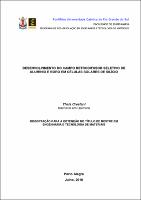| Share record |


|
Please use this identifier to cite or link to this item:
https://tede2.pucrs.br/tede2/handle/tede/6985Full metadata record
| DC Field | Value | Language |
|---|---|---|
| dc.creator | Crestani, Thais | - |
| dc.creator.Lattes | http://buscatextual.cnpq.br/buscatextual/visualizacv.do?id=K8783497T7 | por |
| dc.contributor.advisor1 | Zanesco, Izete | - |
| dc.contributor.advisor1Lattes | http://buscatextual.cnpq.br/buscatextual/visualizacv.do?id=K4787917H3 | por |
| dc.contributor.advisor-co1 | Moehlecke, Adriano | - |
| dc.contributor.advisor-co1Lattes | http://buscatextual.cnpq.br/buscatextual/visualizacv.do?id=K4787919H0 | por |
| dc.date.accessioned | 2016-10-06T11:11:46Z | - |
| dc.date.issued | 2016-07-07 | - |
| dc.identifier.uri | http://tede2.pucrs.br/tede2/handle/tede/6985 | - |
| dc.description.resumo | As células solares típicas da indústria são fabricadas em silício cristalino tipo p e possuem uma junção pn em uma das faces, e na outra face, é formado o campo retrodifusor. O objetivo deste trabalho foi desenvolver células solares com o campo retrodifusor seletivo de alumínio e boro para possibilitar a passivação na face posterior, com processo industrial. Foram utilizadas lâminas de silício Czochralski tipo p, grau solar. A difusão de boro foi realizada em toda a face posterior da lâmina de silício e por serigrafia foi depositada a pasta de alumínio para formar o campo retrodifusor seletivo nas trilhas metálicas. Avaliou-se influência da temperatura e do tempo de difusão de boro, a temperatura de queima das pastas metálicas, o percentual da área posterior recoberta por alumínio e a passivação com SiO2 nos parâmetros elétricos. A melhor temperatura de difusão de boro foi de 970 °C durante 20 minutos e a temperatura de queima das pastas metálicas foi de 870 °C. A célula com maior eficiência foi obtida com a malha posterior com área de recobrimento de alumínio de 14%. A passivação com SiO2 em ambas as superfícies aumentou a eficiência e o comprimento de difusão dos portadores de carga minoritária aumentou de 490 μm para 665 μm. Com a passivação, a eficiência aumentou de 15,6 % para 16,1 %, devido ao aumento do fator de forma e da tensão de circuito aberto. A passivação também aumentou a eficiência quântica interna no intervalo de comprimento de onda do violeta/azul bem como na região do infravermelho próximo. | por |
| dc.description.abstract | The typical solar cells of the industry are fabricated in p-type crystalline silicon wafers and have a pn junction at one side and, on the other side, the back surface field (BSF). The objective of this work is to develop solar cells with aluminum and boron selective back surface field to enable the passivation on the rear face with an industrial process. Czochralski p-type silicon wafers of solar grade quality were used. The boron diffusion was performed on the whole back side of the silicon wafers and the aluminum was screen-printed to form the selective back surface field under the metal grid. The boron diffusion temperature and time, the firing temperature of the metal pastes, the percentage of the rear area covered with aluminum and the passivation with SiO2 were evaluated in the electrical parameters. The best boron diffusion temperature was 970 ° C for 20 minutes and firing temperature of the metal pastes was 870 ° C. The solar cell with the highest efficiency were obtained for a rear metal grid with 14 % of the area covered by aluminum. The passivation by SiO2 on both surfaces increased the minority charge carrier diffusion length from 490 μm to 665 μm. Consequently, the passivation increased the efficiency from 15.6 % to 16.1 %, as a result of an increasing of the fill factor and the open circuit voltage. The passivation also increased the internal quantum efficiency in the range of violet/blue wavelengths as well as in the near infrared region. | eng |
| dc.description.provenance | Submitted by Setor de Tratamento da Informação - BC/PUCRS ([email protected]) on 2016-10-06T11:11:45Z No. of bitstreams: 1 DIS_THAIS_CRESTANI_COMPLETO.pdf: 3613694 bytes, checksum: 40503ab7961f50b87d67545be969f402 (MD5) | eng |
| dc.description.provenance | Made available in DSpace on 2016-10-06T11:11:46Z (GMT). No. of bitstreams: 1 DIS_THAIS_CRESTANI_COMPLETO.pdf: 3613694 bytes, checksum: 40503ab7961f50b87d67545be969f402 (MD5) Previous issue date: 2016-07-07 | eng |
| dc.format | application/pdf | * |
| dc.thumbnail.url | http://tede2.pucrs.br:80/tede2/retrieve/166388/DIS_THAIS_CRESTANI_COMPLETO.pdf.jpg | * |
| dc.language | por | por |
| dc.publisher | Pontifícia Universidade Católica do Rio Grande do Sul | por |
| dc.publisher.department | Faculdade de Engenharia | por |
| dc.publisher.country | Brasil | por |
| dc.publisher.initials | PUCRS | por |
| dc.publisher.program | Programa de Pós-Graduação em Engenharia e Tecnologia de Materiais | por |
| dc.rights | Acesso Aberto | por |
| dc.subject | CÉLULAS SOLARES | por |
| dc.subject | SILÍCIO | por |
| dc.subject | ENGENHARIA | por |
| dc.subject.cnpq | ENGENHARIAS | por |
| dc.title | Desenvolvimento do campo retrodifusor seletivo de alumínio e boro em células solares de silício | por |
| dc.title.alternative | Development of the selective back surface field of aluminium and boron in silicon solar cells | eng |
| dc.type | Dissertação | por |
| Appears in Collections: | Programa de Pós-Graduação em Engenharia e Tecnologia de Materiais | |
Files in This Item:
| File | Description | Size | Format | |
|---|---|---|---|---|
| DIS_THAIS_CRESTANI_COMPLETO.pdf | Texto Completo | 3.53 MB | Adobe PDF |  Download/Open Preview |
Items in DSpace are protected by copyright, with all rights reserved, unless otherwise indicated.




